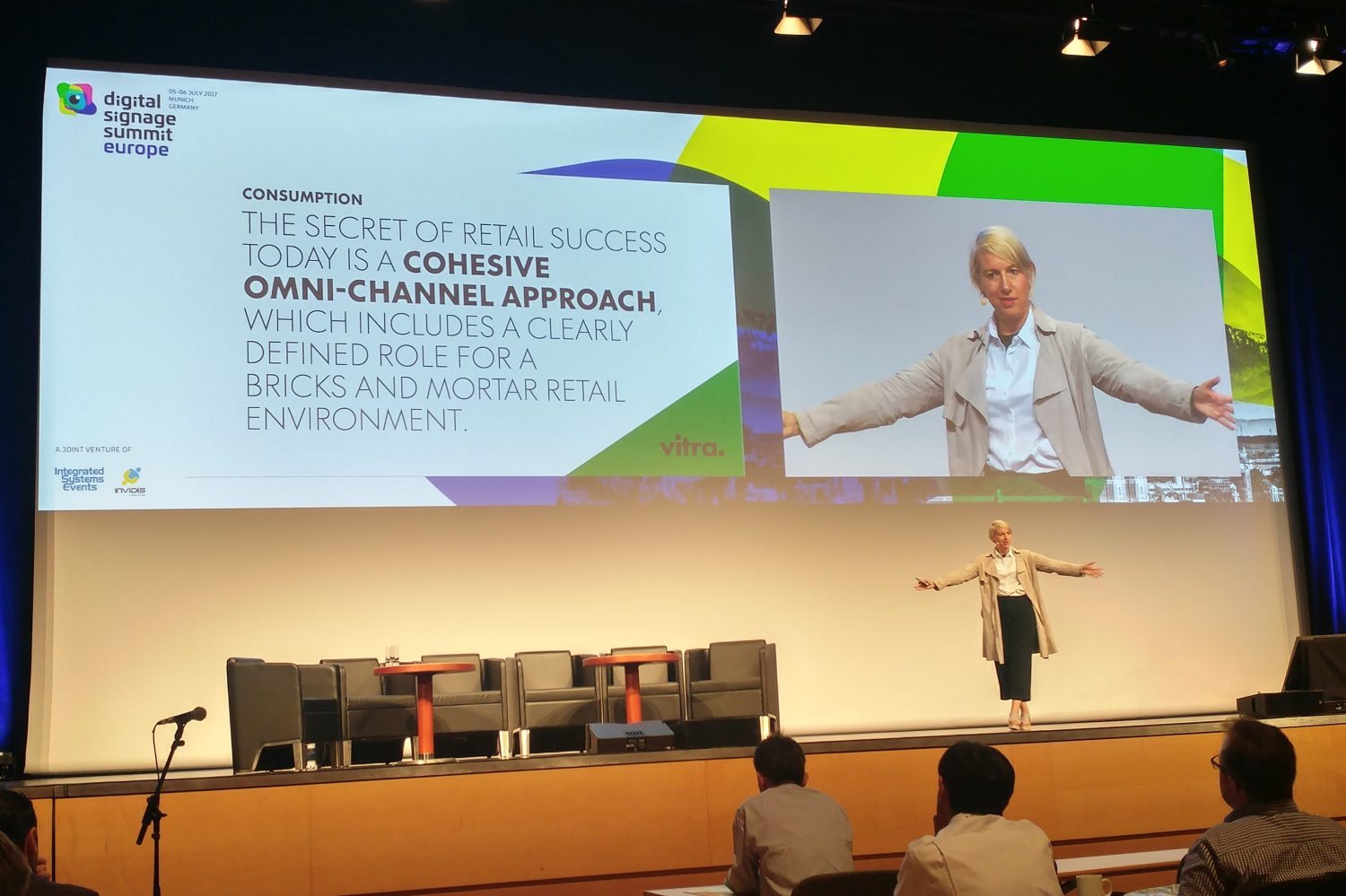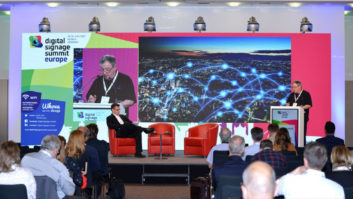
The retail sector continues to be a fast-developing area for digital signage – and was the focus of many of the presentations at the Digital Signage Summit Europe, held in Munich on 5-6 July.
On the first morning Sabine Krieg (pictured), global head of segment retail at shopfitting specialist Vitra International, discussed ten global retail drivers: convenience, engagement, flexibility, reducing complexity, holism, personalisation, transparency, cohesion, encompassment and value. Many of these drivers were illustrated in subsequent sessions.
For instance Fredrik Holmvik, head of media at Swedish supermarket chain ICA Group, gave a presentation about how the group has envisaged a true omnichannel experience: personalisation, convenience, engagement, transparency and reducing complexity all featured.
Holmvik reminded his audience that the term ‘omnichannel’ is sometimes misused. It doesn’t simply mean the same as multichannel; it implies an exchange of information between channels to give customers a seamless experience when moving between them. For instance, Apple’s use of the AppleID means that it has an up-to-date picture of each customer’s activity that it can use in both online and in-store interactions.
ICA is working to put in place a set of systems based around the use of an ‘ICA ID’ and app which will enable customers to receive a more personalised approach, and to shop on their own terms. For instance, they will be able order groceries online, then add to the order when they visit the store; decide to have their shopping delivered rather than taking it home with them; have dietary requirements and intolerances saved within their profile, so that they don’t accidentally buy unsuitable products, and source out-of-stock items from other branches.
A more familar approach to retail customer engagement was presented by Daniel Tomè, interactive techniology specialist Touchwindow. Elnòs Shopping is an Italian shopping centre, based around an IKEA store, which is designed to be a meeting place offering leisure and entertainment as well as shopping experiences.
Touchwindow installed a 6 x 1 wall of 55in portrait displays which shows standard digital signage content if no-one is nearby; but if a shopper approaches the wall, the layout changes and they are invited to play one of 20 games. There is also a 3×3 social wall of 55in displays, plus interactive touch tables offering games, activities, newspapers and magazines to read, and an interactive store directory.
Users connect to the free ‘Social WiFi’ with their social media accounts, enabling marketing data to be collected about stores visitors and helping to improve understanding of their shopping habits, with a view to creating an even better customer experience.
Looking beyond pure retail applications, a number of sessions explained how various IT-based technologies are being implemented within digital signage and/or DOOH to improve the customer journey, yield a better understanding of consumer behaviour, or both.
Arjen de Jong, marketing and sales manager at Snakeware, presented some use cases of location-based beacon technology. For instance, in a Dutch bank, when customers arrive for an appointment they are greeted by the app and given the name and photo of the mortgage adviser they will be meeting. At the same time, counter staff are told the identity of the customer who has just entered, so they can greet them by name.
Beat Fischer, business development manager digital at LINK Institut, described how beacon technology had been used to analyse the effectiveness of outdoor advertising campaigns in Berne, Switzerland. Using a combination of beacons on DOOH displays and post-campaign research, LINK was able to determine for three campaigns that greater exposure to the messages led to an increase in customer activity.
Michael Macmillan, co-founder of Shopperlab, described how artificial intelligence has been used to simulate consumer eye-tracking studies to 96% accuracy. The technology has been deployed in an app, he said, so that “you can compare the visual impact of your signage versus your competitors’, just using your mobile” – rather than carrying out time-consuming studies with samples of consumers.
Programmatic advertising is also making its presence felt in the DOOH market. Sebastian Op het Veld, head of programmatic with My AdBooker and Roel Pennings, director of operations, CS Digital Media, described how programmatic targeting has been integrated into Shell’s new Smart Fuel pump platform, CIS. This to recognise personal profiles and vehicle information at the pump. Additionally, the ‘Fuel Exchange’ offers price or loyalty offers to vehicles in the nearby area.






